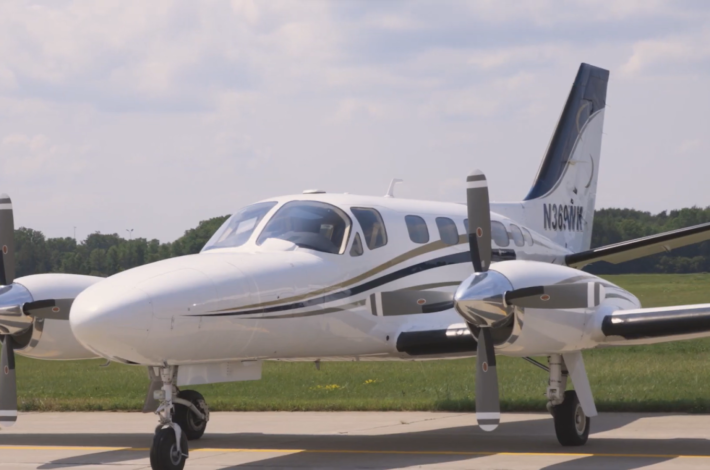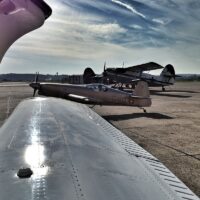
The Conquest II, popularly referred to as the Cessna 441, made its mark as an innovative turboprop aircraft that aimed to bridge the divide between Cessna’s well-established piston engine models and their rapidly expanding line of successful jet aircraft.
In 1974, Cessna embarked on the development of their first turboprop airplane, with customer deliveries commencing in 1977. The aircraft’s initial iteration derived from the Cessna 435, subsequently rebranded as the Conquest II in 1983. This nomenclature was chosen to differentiate it from a smaller aircraft already in the market, the Cessna 425 Conquest I.
During its introduction, the Cessna 441 offered a compelling alternative to small jets, delivering superior affordability and accessibility for pilots transitioning from piston-driven aircraft. Initially, the aircraft experienced positive reception and demonstrated promising performance. However, its journey was not without setbacks.
Early on, a series of incidents occurred due to elevator and trim tab issues, leading to the breakup of a few Cessna 441s in flight. This resulted in a temporary decline in popularity and trust for the aircraft. Nevertheless, Cessna persisted in addressing these challenges, subsequently resolving the problems in later models. Consequently, the Cessna 441 regained its standing and achieved a level of success.
Despite this resurgence, production of the Conquest II came to an end in 1986, with a total of 362 units manufactured. While the aircraft’s lifespan was relatively brief, its contributions to the industry and its position as Cessna’s first venture into the turboprop domain remain noteworthy.
General Characteristics
| Specification | Value |
|---|---|
| Crew | 1 or 2 pilots |
| Capacity | 8-10 passengers |
| Length | 39 ft 0 in (11.89 m) |
| Wingspan | 49 ft 4 in (15.04 m) |
| Height | 13 ft 2 in (4.01 m) |
| Wing area | 253.6 sq ft (23.56 m2) |
| Aspect ratio | 9.6:1 |
| Airfoil | NACA 23018 at root, NACA 23019 at tip |
| Empty weight | 5,682 lb (2,577 kg) |
| Gross weight | 9,850 lb (4,468 kg) |
| Powerplant | 2 x Garrett TPE331-8-403S turboprops, 636 shp (474 kW) each |
| Propellers | 4-bladed McCauley |
Performance
| Specification | Value |
|---|---|
| Maximum speed | 340 mph (550 km/h, 300 kn) at 16,000 ft (4,875 m) |
| Cruise speed | 298 mph (480 km/h, 259 kn) at 35,000 ft (10,700 m) |
| Stall speed | 86 mph (139 km/h, 75 kn) flaps and gear down |
| Range | 2,525 mi (4,064 km, 2,194 nmi) at 35,000 ft (10,700 m) |
| Service ceiling | 35,000 ft (11,000 m) |
| Rate of climb | 2,435 ft/min (12.37 m/s) |
Costs
The initial price tag of the Cessna 441 was approximately one million dollars. However, as the aircraft reached the end of its production in 1986, the cost of a brand-new model skyrocketed to a staggering $1.795 million, representing the peak of the market at that time.
As years went by, the price gradually declined, reaching $1.5 million by 1998. Presently, recent listings on platforms like Trade-a-Plane typically feature prices slightly below one million dollars, with some exceptionally maintained models still commanding prices up to the $1.5 million range.
Performance and Handling
Despite encountering some initial challenges, the performance and handling of the Cessna 441 have garnered high praise from new owners. Pilots cannot speak highly enough of its ease of flying, with no negative characteristics or quirks to be found. The aircraft is known for its comfort, reasonable noise levels, and enhanced safety now that the early issues have been resolved.
Overall, the Cessna 441 exhibits pleasant and well-balanced controls, along with reliable landing gear, allowing for smooth landings and excellent maneuverability on the runway. It boasts outstanding speed, range, and climb performance, surpassing many comparable aircraft in terms of fuel efficiency.
When operating at higher altitudes, the Cessna 441 excels without encountering the struggles that often plague other turboprop aircraft, as reported by operators. In fact, some owners have perfectly summarized its capabilities, highlighting its ability to reach 35,000 feet, fly at speeds exceeding 300 knots, consume a fuel rate of 65 gallons per hour, and cover 2,000-mile legs.
In conclusion, despite the initial hurdles, Cessna has undoubtedly produced a highly successful and efficient aircraft in the form of the Cessna 441. The satisfaction of the owners, who truly matter, attests to its exceptional performance.
Maintenance Schedule
Over time, the majority of issues found in early models of the Cessna 441 have been addressed, with service bulletins implemented and problems rectified. Even older aircraft are likely to have undergone necessary maintenance and snag resolutions.
However, prospective buyers should exercise caution and thoroughly examine the aircraft’s maintenance history to ensure compliance with service requirements and the completion of all necessary actions.
When operating a Cessna 441, it is crucial to be mindful of certain areas that may require attention. These areas of concern encompass various aspects, such as potential environmental system problems, the condition of the nosewheel, instances of starter and generator failures, window delamination, and wheel-well modifications.
While these issues have been identified as potential trouble spots that warrant careful monitoring, it is important to note that, aside from these specific concerns, adhering to standard maintenance procedures applicable to other turboprop aircraft should not present excessive challenges. By following routine maintenance practices and paying due diligence to the aforementioned areas, owners and operators can effectively uphold the continued reliability and safe operation of the Cessna 441. Proactive maintenance and thorough inspections are key to ensuring optimal performance and the longevity of this aircraft.
Modifications and Upgrades
Unlike smaller and more common aircraft, the availability of modifications for the Cessna 441 or similar turboprops is limited. The primary reason behind this is the lack of sufficient demand in the market for such modifications.
However, several noteworthy enhancements deserve attention. Among them, two significant modifications stand out, namely the transition from the stock -8 engines to the upgraded -10 variant, renowned for its superior power, and the replacement of the original three-bladed propellers with cutting-edge Hartzell four-bladed propellers. The installation of these new propellers not only reduces noise but also enhances acceleration and climb performance, offering valuable benefits to Cessna 441 owners.
When it comes to enhancing and customizing the Cessna 441, there are two well-known companies that excel in providing these specialized services. The first company is Executive Wings, recognized for its exceptional expertise in engine and propeller conversions. They offer comprehensive packages that encompass upgrading the stock -8 engines to the more powerful -10 variant, along with replacing the original three-bladed propellers with advanced Hartzell four-bladed propellers. Additionally, Executive Wings provides soundproofing packages that significantly enhance the cabin experience, ensuring a quieter and more comfortable flight. Furthermore, they offer winglet installations, which not only enhance the aesthetics of the aircraft but also improve its aerodynamic performance, resulting in better fuel efficiency and overall flight characteristics. With their extensive range of services, Executive Wings is a top choice for Cessna 441 owners seeking to optimize their aircraft’s performance and comfort.
Another notable company in this field is West Star Aviation. Like Executive Wings, they excel in engine and propeller conversions, ensuring that the Cessna 441 operates at its peak performance. West Star Aviation also specializes in soundproofing solutions, creating a quieter and more comfortable environment for passengers and crew. However, their services extend beyond performance enhancements. They are well-equipped to cater to specific operational requirements, such as converting the Cessna 441 into an air ambulance. West Star Aviation offers custom interior installations that can transform the aircraft into a fully functional medical transport, meeting the needs of operators who occasionally require this specialized configuration.
Finding Replacement Parts
When it comes to sourcing spare parts for the Cessna 441, there are a few notable organizations that cater to the needs of owners. One such organization is Preferred Airparts, which not only offers a wide range of parts specifically for the Cessna 441 but also provides an extensive selection for various other Cessna aircraft models. Additionally, Cessnaparts.com specializes in meeting the specific requirements of Cessna 441 owners by offering a dedicated inventory of Conquest II parts.
The existence of multiple options indicates that finding replacement parts for the Cessna 441 is generally a manageable task. Whether you prefer to explore online sources or consult with experienced engineers, obtaining the necessary components for your aircraft should not pose significant difficulties. These organizations are committed to supporting Cessna 441 owners by facilitating the maintenance and continued operation of their aircraft, ensuring access to the required parts.
Common Issues
During the early stages of production, the Cessna 441 encountered significant challenges, as mentioned earlier. The focus of these challenges revolved primarily around the elevator and trim tab, which persisted over an extended period and resulted in several serious accidents.
Cessna dedicated substantial resources and efforts to tackle these issues, even going so far as to ground the entire fleet on at least one occasion. In the end, early owners were rightfully compensated, and effective solutions were implemented to address and resolve all the problems. However, this unfortunate series of events had a negative impact on the perceived reliability and reputation of the Conquest II.
Despite these initial setbacks, it is important to note that Cessna took swift action to rectify the problems and ensure the safety and performance of the Cessna 441. Subsequent modifications and improvements were implemented, leading to enhanced reliability and customer satisfaction. While the challenges during the early production stages had an impact on its reputation, the Conquest II has evolved into a reliable and capable aircraft, gaining the trust of owners and operators over time.
As previously mentioned, the issues surrounding the aircraft were eventually fully resolved, bringing long-term benefits to early owners as Cessna provided extensive support for both the aircraft and its owners. Furthermore, the problems did not resurface in later redesigned models, allowing the entire situation to gradually fade away from public memory.
Since then, the most significant problem encountered pertains to occasional power loss in the engines. Reports emerged between 1979 and 1980 of unexplained power loss incidents occurring as the aircraft accumulated approximately 500 hours of operation. These incidents prompted heightened scrutiny and efforts to identify and rectify the root causes, ensuring the continued safety and reliability of the Cessna 441.
Upon further investigation, it was discovered that carbon accumulation in the combustion chambers was responsible for erosion in the hot-section components, resulting in power loss. However, a subsequent modification was developed and implemented to effectively address this issue. As a result, the majority of Cessna 441 aircraft have received this modification, leading to a resolution of the problem. Consequently, the Cessna 441 is now widely regarded as a trouble-free aircraft, instilling confidence in its performance and reliability.
Insurance Options
Cessna 441 insurance, like all aircraft insurance, can be divided into two primary components: liability insurance and hull insurance. Liability insurance is a mandatory coverage that protects against damages caused by the aircraft, while hull insurance is optional and covers damage or loss to the aircraft itself.
For the Cessna 441, liability insurance typically provides coverage between $1,000,000 and $1,250,000 per incident. This coverage includes protection for passengers, although individual insurance companies may set specific limits for passenger liability coverage, ranging from $100,000 to $1,000,000 per passenger. The coverage for passenger liability is generally included within the total liability coverage amount. Regarding hull insurance, the agreed value is determined during the initial insurance quoting process. In this process, the aircraft owner requests an insurance quote for their Cessna 441 Conquest II, stating their estimated value for the aircraft. The insurance company then agrees upon this value before providing a quote for hull coverage.
To provide some examples, as of 2021, there were eight insurance companies offering coverage for Cessna 441s. The cost of an annual policy with $1,000,000 in liability coverage and $1,250,000 in hull coverage varied between $6,800 and $9,600 per year for qualified pilots. For those who opt for liability coverage only, the cost was notably lower, ranging between $1,250 and $1,600 per year.
It’s important to note that these figures are from 2021 and may have changed since then. When seeking insurance for a Cessna 441, it is advisable to consult with insurance providers to obtain the most up-to-date and accurate quotes based on individual circumstances and coverage requirements.
Resale Value
The resale value of the Cessna 441, like any aircraft, is predominantly influenced by the level of maintenance and care it has received. However, in general, the Cessna 441 tends to retain its value quite well, as evident from sales figures spanning multiple years.
Initially, the aircraft was sold for approximately one million dollars, which later increased to around one million and three-quarter dollars. Presently, while it is possible to find some available for $600,000 or more, the average price remains around one million dollars.
The clear conclusion is that by ensuring diligent care and maintenance for your Cessna 441, you not only safeguard your own well-being but also contribute to the preservation of its value over time.
Reviews
Reviews of the Cessna 441 are a mixed bag, which is to be expected given the aircraft’s turbulent history. Early buyers encountered specific issues similar to those already mentioned. Here are a few examples:
“I purchased serial 79 at the beginning of 1979 and unwittingly became part of Cessna’s experimental department. It was not until December of ’79, after numerous updates and improvements including a new tail, that the aircraft was finally airborne again. I was quite dissatisfied as a customer. Cessna provided me with a 340 to use during the downtime, which was better than nothing but far from satisfactory after investing a million dollars in a turboprop.”
However, once the early problems were resolved, most owners expressed satisfaction with their purchases, as one would expect with an aircraft of such substantial cost. Here are some comments regarding more recent Cessna 441s:
“The handling characteristics are an absolute pleasure. The control harmony and responsiveness are simply superb; flying this aircraft is a delight.”
The same owner continued, stating:
“I believe the 441 to be one of the finest combinations of power, performance, range, and economy in its class. It faced limited competition in the 70s and 80s and may have even fewer rivals now. It stands in a class of its own.”
Similar sentiments were echoed by other owners. Most described the aircraft as “a joy to fly,” with minimal flaws. They found it easy to operate and, in contrast to the early models, highly safe.
Even owners who purchased early models and had to undergo updates and improvements due to tail flutter problems expressed satisfaction with their purchase once the necessary work was completed. They praised the aircraft’s comfort, efficiency, and performance.
Examining the Alternatives
According to numerous owners, the Cessna 441 can be regarded as a truly unique aircraft. It successfully fills a significant void between piston twins and jet aircraft, a feat accomplished by few others in the aviation industry during its initial production period.
At the time of its introduction, there were scarce alternatives that could match the capabilities of the Cessna 441. However, since the development of the Conquest, several turboprop aircraft have emerged, including the Beech Starship and Piaggio Avanti. These models are considered the closest counterparts to the Cessna 441, sharing similar characteristics and functionalities.
Which Clubs You Can Join
Surprisingly, despite the relatively low number of Cessna 441 aircraft in operation, there are dedicated owner/operator organizations available. The Conquest Aircraft Operators Group serves as a specific community for Cessna 441 owners, while the Cessna Conquest Owners Organization is another valuable club for owners and operators to join.
Furthermore, the Cessna Flyer Association remains an excellent club for Cessna 441 owners, as well as owners of other Cessna aircraft. Additionally, the Cessna Owner Organization provides resources and support for Cessna aircraft owners. There is also a small Facebook group dedicated to owners of Cessna 441s, along with various other similar Cessna types.
However, it is worth noting that the number of specific groups for the Cessna 441 is relatively fewer compared to smaller and more popular aircraft. This can be attributed to the global fleet of Cessna 441, which consists of just over 300 aircraft still in active service worldwide.
Conclusion
Based on the evidence presented, it is evident that the Cessna 441 Conquest II is a widely favored, reliable, and user-friendly aircraft. As a turboprop, it effectively fills the space between Cessna’s piston-engined planes and their jet counterparts.
For pilots seeking a seamless transition from simpler piston-engined aircraft to more advanced options without taking the leap to a full-fledged jet, the Cessna 441 could be an excellent choice. As long as they possess the financial means to acquire a Cessna 441 and cover its maintenance costs, they are unlikely to be disappointed with their decision.
Frequently Asked Questions
Yes, there was a previous aircraft known as the Conquest I. The Cessna 425 had been marketed as the Conquest I earlier, necessitating the designation of the Cessna 441 as the Conquest II.
For an average owner flying approximately 450 hours per year, with fuel priced at $4.25 per gallon, the Cessna 441 Conquest II has estimated total variable costs of around $550,125 and total fixed costs of approximately $59,758. Therefore, an annual budget of approximately $609,883 would be required.
According to most owners, the Cessna 441 is generally regarded as an easy aircraft to fly. However, being a turboprop, it presents a more complex operational experience compared to piston-engine aircraft, with notable differences. If transitioning to the Cessna 441 from a simpler single piston-engined aircraft, it is advisable to undergo adequate training before attempting solo flights.

